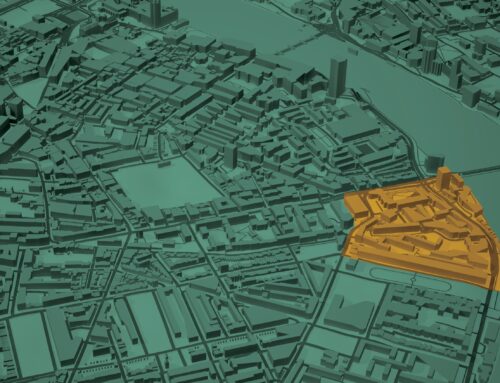Assessing the value proposition that American communities offer their residents
By Ben Glasner and Kenan Fikri
When deciding where to live, families regularly find themselves caught balancing affordability with other characteristics, amenities, and opportunities that they may desire in a community. Many of the most desirable places to live are also among the most expensive, while many of the cheapest have limited job opportunities and struggle to attract and retain residents.
At the same time, Americans are more stuck in place than ever, with long distance migration rates near historic lows and the supply of new housing construction lagging far behind both the demand for it and population growth. So while some Americans can choose where to live, others are essentially bound by what’s on offer to them based on where they are or what they can afford.
So which communities offer Americans the good life and which offer them more of a mixed bag of trade-offs around financial security and well-being?
We take a stab at answering this question by combining two datasets: The Economic Policy Institute (EPI)’s Family Budget Calculator (FBC) and EIG’s own Distressed Communities Index (DCI):
- The FBC estimates a two-parent, two-child family’s cost of securing a modest standard of living, accounting for the local prices of housing, food, transportation, healthcare, childcare, taxes, and other necessities. We then take the median income of a married family with children in the county and estimate how much income they have left over after costs to measure economic security.
- The DCI provides a community-level gauge of comparative economic well-being. The index ranks counties on seven indicators ranging from the poverty rate to the rate of job growth, placing them into one of five categories, or quintiles, of well-being: prosperous, comfortable, at risk, mid-tier, or distressed.
Combined, the two datasets allow us to examine which places offer American families high levels of personal economic security alongside community prosperity–and which do not.
Americans gravitate to places that offer good deals
Zooming in on the tails of the distribution, we can start to differentiate places that offer:
- Secure prosperity: Counties in the top two quintiles of the DCI (prosperous and comfortable categories) where the typical two-parent, two-child household has at least $2,000 left over after essential costs (as per the FBC) each month.
- Precarious prosperity: Counties in the top two quintiles of the DCI where the typical two-parent, two-child household does not earn enough to cover essential costs.
- Moderated distress: Counties in the bottom two quintiles of the DCI (at risk and distressed categories) where the typical two-parent, two-child household has at least $2,000 left over after essential costs each month.
- Burdened distress: Counties in the bottom two quintiles of the DCI where the typical two-parent, two-child household does not earn enough to cover essential costs.
Secure prosperity
One-quarter of Americans reside in communities that offer both economic security and high levels of local economic well-being. Counties in this category tend to be affluent suburbs where residents enjoy high incomes, making it easier to cover basic household costs. The median monthly family income across these counties is approximately $11,300 compared to a $8,300 cost base. Counties that exemplify this category include: suburbs of Washington, DC (Arlington County, VA and Loudoun County, VA); Delaware County, OH (outside Columbus); and Williamson County, TN (near Nashville).
A number of affluent urban counties fall into this category as well, including Fulton County, GA (Atlanta) and the central Bay Area counties like Santa Clara, CA, where very high incomes help the typical family (although by no means all families) afford the necessities. Secure prosperity prevails along the Eastern Seaboard–although DC is the only urban core in the corridor represented here–and across much of the upper Midwest. Notably, nearly all of the Columbus, Cincinnati, and Pittsburgh metro areas fall into this category.
Precarious prosperity
A number of other counties offer a more Faustian bargain, however, where families can enjoy being surrounded by high levels of economic well-being but struggle to make ends meet. Many of these counties can be found in the Sun Belt and West. Precarious prosperity prevails across much of California, in South Florida, and in blue collar suburbs of white collar metro areas (like Adams County, Colorado, outside of Denver). It is also common in expensive recreation areas in the Mountain West, where working families struggle to get by in places like Eagle County, Colorado (Vail) or Blaine County, Idaho (Sun Valley), where the wealthy have second homes. Costs exceed incomes by $500 a month in these counties, on average. All together, 10.5 percent of the country’s population, or nearly 35 million Americans, reside in areas that offer only such tenuous footholds in the American Dream.
Moderated distress
The smallest segment of the population (4 million people) lives in the handful of economically at-risk counties that still offer the typical family comfortable standards of living. These places combine decent average incomes with relatively low costs. Many of these are urban counties that have grappled with economic decline and population loss–forces presumably helping to keep costs low for those who remain–but retain large white collar or knowledge economy job bases at the same time. Examples include: Essex County, NJ (Newark); Richmond city, VA; St. Louis city, MO; New Orleans, LA; Peoria County, IL; and Lucas County, OH (Toledo). In these communities, lower costs of living can help moderate the burden of living in distressed or at risk communities on families, at least financially. In rural settings, many mining or energy-production communities fall into this category. These counties combine much higher incomes than other distressed counties ($9,700 a month on average, $2,100 higher than the precarious prosperity category) with lower costs per month than the burdened distress category.
Burdened distress
Finally, 19.5 million Americans reside in communities with poor value propositions where economic well-being runs low and cost burdens run high. For the typical county in this group, a monthly income of $6,300 falls well short of the $7,000 needed to secure a decent standard of living. Bronx County, NY, is the clear outlier even here, where the typical family’s income falls more than $4,000 short of covering basic costs even as the overall health of the county economy falls toward the bottom of the rankings nationally. A number of other very low-income counties in California’s Central Valley and along the Southern border round out this group among metropolitan areas. Among rural areas, families in chronically distressed portions of Appalachia, the Southwest, the Deep South, and many tribal areas must contend with these double burdens, too.
A land as diverse with such an uneven economic geography as the United States will inevitably house a range of standards of living. The majority of Americans live in communities that fall somewhere in between the extremes presented here, getting by in places that offer average levels of well-being and modestly positive levels of economic security. This crosswalk of two complementary datasets on family economic security and community economic well-being illuminate the starkly different circumstances in which Americans live. A plurality of Americans are ensconced in places that offer them and their families the good life: high incomes that secure their standards of living. And yet precarity–driven in some places by high costs, but in most by low incomes–still characterizes the economic position of too many American families and communities. The Distressed Communities Index can help identify such places and inform strategies to foster the growth of good jobs and quality economic development.






